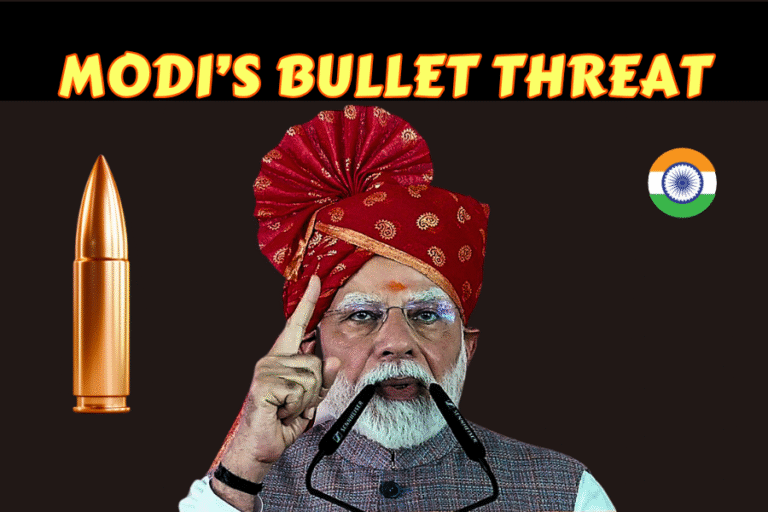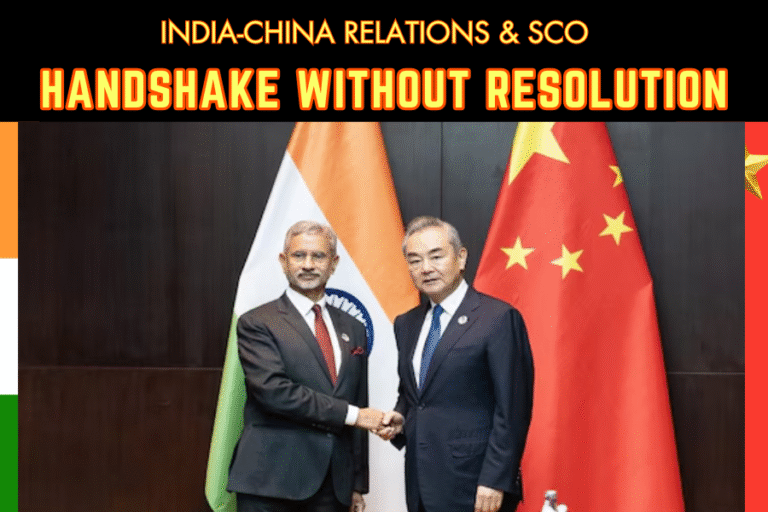(By Khalid Masood)
1. The India-Israel Nexus: Historical and Strategic Foundations
India and Israel have cultivated a robust strategic partnership since establishing full diplomatic relations in 1990s, driven by shared security concerns, counterterrorism imperatives, and complementary defence needs. This “nexus” is rooted in mutual perceptions of hostile neighbors—Pakistan and China for India, and Iran and Arab adversaries for Israel. Despite India’s initial non-aligned, pro-Arab stance post-1947, geopolitical shifts, including the Gulf War, the end of the Cold War, prompted India to formalize ties with Israel.
Key Milestones
- 1947–1980: India recognized Israel in 1950 but delayed full relations due to Arab oil dependencies and domestic Muslim vote considerations. Limited covert cooperation existed, notably during the 1971 Indo-Pak War, when Israel provided arms and intelligence to India.
- 1980-1990: A covert nexus between India and Israel aimed at undermining Pakistan’s nuclear program existed as the 1980s and into the 1990s. This alliance plotted a joint airstrike on Pakistan’s uranium enrichment facility at Kahuta, with Israeli F-16 and F-15 jets operating from Indian airbases to carry out the mission. The plan, reminiscent of Israel’s 1981 strike on Iraq’s Osirak reactor, was reportedly abandoned following strong warnings from Pakistan and a crucial tip-off from the CIA to then-President General Zia-ul-Haq. This episode underscores the long-standing strategic collaboration between India and Israel against Pakistan.
- 1992: Establishment of diplomatic ties, catalyzed by global realignments and India’s need for advanced technology post-Pokhran sanctions.
- 1999 Kargil War: Israel supplied mortars, ammunition, and laser-guided missiles, proving its reliability during crises, unlike Western nations that imposed sanctions.
- 2017–2022: Prime Minister Narendra Modi’s visit to Israel elevated ties to a “strategic partnership,” with a focus on defence, technology, and counterterrorism.
- 2022: Defence Ministers Rajnath Singh and Benjamin Gantz signed the “India-Israel Vision on Defence Cooperation,” outlining a 10-year for collaboration in drones, missiles, and emerging technologies.
Strategic Drivers
- Counterterrorism: Both nations face threats from militant groups (e.g., Kashmiri freedom fighter for India, Hamas & Hezbollah for Israel), fostering intelligence-sharing and joint training.
- Defence Modernization: India, the world’s largest arms importer, seeks Israel’s advanced technologies to diversify from Russian platforms and counter China-Pakistan axis. Israel, constrained by limited markets due to U.S. vetoes on China sales, views India as a key buyer ($2.9 billion in imports, 2008–2023).
- Geopolitical Alignment: Shared concerns over Iran’s missile program and China’s growing influence in the Middle East and South Asia strengthen the partnership. India’s role in the I2U2 Group (India, Israel, UAE, U.S.) and Quad reinforces this.
- Ideological Affinity: Under Modi and Netanyahu, nationalist narratives emphasizing anti-terrorism and minority marginalization align, as noted in X posts like @Kahlissee, though such claims oversimplify complex domestic dynamics.
Current Dynamics
By 2025, Israel is India’s fourth-largest arms supplier, providing 42.1% of Israel’s military exports. Bilateral trade, excluding defence, reached $6.3 billion in 2019, with ongoing free-trade agreement negotiations. High-level visits, such as General M.M. Naravane’s 2021 trip to Israel and Gantz’s 2022 visit to India, underscore deepening ties. Posts on X, like @OopsGuess, highlight ideological alignment but exaggerate anti-Muslim narratives, which are not official policy.
2. Extent of Military Cooperation
India-Israel military cooperation spans arms sales, joint ventures, technology transfers, and training, with a strong focus on drones, missiles, and surveillance systems. This partnership enhances India’s capabilities along its borders with Pakistan and China and in counterinsurgency operations in Kashmir.
Arms Sales and Hardware Supply
- Total Imports: India imported $4.2 billion in Israeli arms from 2001–2021, including $2.9 billion from 2008–2023, covering radars, drones, missiles, and sensors.
- Key Systems:
- Barak-8 Missile System: A joint DRDO-IAI project, deployed on land and naval platforms, intercepts aircraft, drones, and missiles up to 150 km. Contracts worth $2.6 billion (2017–2018) equip Indian Navy warships.
- Tavor and Galil Rifles: Used by Indian Special Forces for precision operations, including the 2016 surgical strikes in PoK.
- Spice-2000 Guidance Kits: Employed in the 2019 Balakot airstrikes, enhancing precision targeting.
- Sensors and Night Vision: Hand-held thermal imaging and night vision devices bolster counterinfiltration along the Line of Control (LoC).
Armed and Surveillance Drones
Drones are a cornerstone of India-Israel defence ties, with Israel Aerospace Industries (IAI) as the primary supplier. India’s drone acquisitions align with its precision-strike doctrine, minimizing risks to manned aircraft.
- Harop Loitering Munitions:
- Capabilities: Fly up to 35,000 feet, immune to GNSS jamming, with precision strike and intelligence-gathering functions. They can self-destruct on targets or return if unengaged.
- Deployment: Used in Operation Sindoor (May 2025) for strikes on terror camps in Pakistan and PoK, reflecting India’s shift to unmanned systems post-Rafale losses.
- Challenges: Pakistan claimed to have downed 25–77 Harops in May 2025, possibly with Azerbaijan’s intelligence, highlighting vulnerabilities at lower altitudes.
- Heron Series (Surveillance and Armed):
- Heron Mark-2: High-altitude surveillance drones deployed in Kashmir and along the Line of Actual Control (LAC) with China. Leased in 2021 for LAC missions.
- Heron TP: Approved for purchase in 2015, these armed drones offer deep-strike capabilities. India plans to integrate indigenous weapons, supported by IAI collaboration.
- Drishti-10 Starliner: Produced by Adani Defence with IAI technology, inducted into the Indian Navy in 2025 for Indian Ocean surveillance and ordered for LAC deployment.
- Joint Production: Negotiations for Heron co-production under “Make in India” are advanced, with IAI and DRDO collaborating on UAVs for naval and army use.
Joint Exercises and Training
- Blue Flag Exercise (2021): Indian Air Force participated in Israel’s multinational air exercise, enhancing interoperability.
- Counterterrorism Training: Israeli expertise in urban warfare and interrogation tactics is shared with Indian Special Forces, though alleged operative involvement in Kashmir interrogations is controversial and unverified.
- Naval Visits: Goodwill visits and joint maritime exercises strengthen naval cooperation, focusing on anti-piracy and ISR (intelligence, surveillance, reconnaissance).
- Seminars: A 2024 seminar in New Delhi showcased Israeli anti-drone technologies (e.g., Smart Shooter, ELTA Systems), fostering B2B ties with Indian firms.
Technology Transfers and Joint Ventures
- Barak-8 Development: Co-developed by DRDO and IAI, exemplifying technology transfer.
- Hela Systems: IAI’s joint venture with Tata Advanced Systems for electronic warfare and homeland security.
- BF Elbit Advanced Systems: Elbit Systems and Bharat Forge supply artillery and munitions, integrating Israeli technology.
- Mid-Air Refuelers: IAI collaborates with Hindustan Aeronautics Limited to convert Boeing-767s for IAF use.
Strategic Impact
Israeli drones and systems have enhanced India’s ISR and precision-strike capabilities, critical for LoC counterinfiltration and LAC surveillance. The partnership supports India’s “Make in India” initiative, reducing reliance on Russian platforms (e.g., MiG-29s) and countering Pakistan’s Chinese-supplied J-10CE jets.
3. India’s Tactics to Maintain Arab Relations
India very cunningly employs a “selective alignment” approach to balance its Israel partnership with strong ties to Arab nations, particularly Gulf states, driven by economic, energy, and diaspora interests.
Economic and Energy Imperatives
- Oil and Trade: Gulf countries (Saudi Arabia, UAE, Qatar) supply 60% of India’s oil and host 8.9 million Non-Resident Indians (NRIs), remitting $50 billion annually. Bilateral trade with Gulf Cooperation Council (GCC) nations reached $184 billion in 2023.
- Investments: UAE and Saudi Arabia have committed $100 billion in Indian infrastructure, with projects like the India-Middle East-Europe Corridor (IMEC) enhancing connectivity.
Diplomatic Tactics
- Neutral Stance on Palestine: India supports a two-state solution and condemns Israeli actions in Gaza (e.g., post-October 2023 Hamas attack), aligning with Arab sentiments. It voted against Israel in UN resolutions while maintaining defence ties.
- Compensatory Diplomacy: India offsets Israel visits with Arab engagements. For example, Modi’s 2017 Israel trip was followed by visits to UAE and Qatar. Defence exchanges with Israel are often discreet, avoiding public backlash.
- Economic Partnerships: India leverages the I2U2 Group and Abraham Accords to align with UAE and Israel simultaneously, framing cooperation as economic rather than anti-Arab.
- Chabahar Port: India’s investment in Iran’s Chabahar Port ensures access to Afghanistan and Central Asia, bypassing Pakistan, and maintains strategic ties with Iran despite U.S. sanctions and Israel’s concerns.
- Cultural Diplomacy: Modi’s outreach, like receiving the UAE’s Zayed Medal (2019), and cultural exchanges (e.g., yoga festivals in Saudi Arabia), project India as a non-threatening partner.
Managing Perceptions
- Discreet Defence Ties: India downplays Israel arms deals in Arab media, emphasizing agriculture and tech cooperation. Most defence visits are undisclosed until after completion.
- Domestic Muslim Vote: The Congress-led UPA (2004–2014) tempered Israel ties to appease Muslim voters, a concern less pronounced under BJP’s Hindu-nationalist agenda, though Modi avoids overt anti-Arab rhetoric.
- OIC Engagement: India secured observer status at the OIC in 2019, despite Pakistan’s objections, signaling Arab acceptance. Saudi Arabia and UAE’s neutral stance on Kashmir further aids India.
Challenges and Criticisms
- Kashmir Narrative: Pakistan and freedom fighter groups exploit India-Israel ties, promoting “Yahud-o-Hanud” (Jewish-Hindu conspiracy) theories in Kashmir. These risks alienating Arab publics but hasn’t disrupted state-level ties.
- Iran Tensions: India’s shift toward Israel and Gulf states strains Iran relations, especially post-U.S. withdrawal from the 2015 nuclear deal, though Chabahar sustains engagement.
- Human Rights Scrutiny: India’s use of Israeli surveillance in Kashmir draws criticism from pro-Palestinian groups, but Gulf monarchies, prioritizing stability, overlook this.
Balancing Accuracy of India
India’s success in balancing Israel and Arab ties stems from:
- Compartmentalization: Separating defence (Israel) from energy and trade (Arabs), minimizing overlap.
- Pragmatic Arab States: Gulf nations prioritize economic ties over ideological conflicts, especially post-Abraham Accords.
- Global Hedging: India’s neutral Ukraine stance and Quad role enhance its multipolar credibility, reassuring Arabs of non-alignment.
- Modi’s Personal Diplomacy: High-profile visits and awards from Gulf leaders project friendship, countering perceptions of an anti-Arab tilt.
India’s strategy is transparent and pragmatic, aligning with Gulf states’ own realpolitik, as evidenced by UAE’s Israel normalization. Ironically Arabs states do not perceive India as duplicitous; rather, they value its economic and strategic contributions.
4. How India Balances Seemingly Opposite Alignments
India’s ability to align with Israel and Arab states simultaneously reflects a multipolar foreign policy, executed with precision through:
- Strategic Autonomy: India avoids exclusive alliances, hedging between Israel, Gulf states, Russia, and the U.S. Its neutral Ukraine stance and discounted Russian oil purchases exemplify this.
- Economic Leverage: Gulf investments and NRI remittances outweigh ideological conflicts, ensuring Arab states prioritize trade over Israel tensions.
- Discreet Defence Deals: Israel arms sales are low-profile, with public focus on agriculture and tech, as seen in I2U2 projects.
- Diplomatic Calibration: Modi’s frequent Gulf visits and OIC engagement counter perceptions of an Israel tilt.
- Regional Frameworks: IMEC and Abraham Accords align India with both Israel and UAE, reducing zero-sum perceptions.
The query’s “seemingly opposite” framing ignores Gulf states’ own normalization with Israel (e.g., UAE, Bahrain). India’s accuracy lies in exploiting this realignment, positioning itself as a bridge between Israel and Arabs.
5. Israel’s Role in the Indo-Pak Military Standoff (May 2025)
The May 2025 Indo-Pak standoff, sparked by the Pahalgam attack and culminating in Operation Sindoor, saw significant Israeli involvement through arms supply, diplomatic support, and strategic alignment. Israel’s overt actions reinforced India’s military posture against Pakistan, though its role was carefully calibrated to avoid broader regional fallout.
Context: Operation Sindoor
- Trigger: A terrorist attack in Pahalgam, Jammu and Kashmir, prompted India’s precision strikes on nine terror sites in Pakistan and PoK, targeting Lashkar-e-Taiba, Jaish-e-Mohammed, and Hizbul Mujahideen.
- Escalation: The conflict featured a major aerial dogfight (125 jets), missile exchanges, and drone warfare, with Pakistan claiming to down 25–77 Indian drones and India reporting Rafale losses. A U.S.-brokered ceasefire ended the 18-day crisis.
Israel’s Overt Support
- Diplomatic Endorsement:
- On May 7, 2025, Israel’s Ambassador Reuven Azar posted on X: “Israel supports India’s right for self-defence. Terrorists should know there’s no place to hide from their heinous crimes against the innocent. #OperationSindoor.”
- Major General (Res) Amir Baram, Israel’s Defence Ministry DG, spoke with India’s Defence Secretary Rajesh Kumar Singh, lauding Operation Sindoor’s success and extending full support against terrorism.
- On May 7, 2025, Israel’s Ambassador Reuven Azar posted on X: “Israel supports India’s right for self-defence. Terrorists should know there’s no place to hide from their heinous crimes against the innocent. #OperationSindoor.”
- Military Hardware:
- Harop Drones: India deployed IAI-manufactured Harop loitering munitions for precision strikes, avoiding further manned aircraft losses after Rafale setbacks. Their use signaled India’s drone-centric doctrine, supported by Israeli technology.
- Skystriker Drones: Adani Group’s Skystriker, built with Israeli expertise under “Make in India,” was used for targeted strikes.
- Heron Mark-2: Provided real-time ISR during strikes, enhancing target acquisition along the LoC.
- Spice-2000 Kits: Likely used for precision bombing kits – though remained ineffective at Balakot.
- Harop Drones: India deployed IAI-manufactured Harop loitering munitions for precision strikes, avoiding further manned aircraft losses after Rafale setbacks. Their use signaled India’s drone-centric doctrine, supported by Israeli technology.
- Technical Assistance: Israel’s expertise in drone operations, honed in Gaza, supported India’s shift to unmanned systems, as noted by Professor Jahara Matisek.
- Historical Precedent: Israel’s Kargil (1999) and Balakot (2019) support, via drones and missiles, set the stage for its 2025 role.
Strategic Implications
- Countering Pakistan: Israeli drones gave India a tactical edge, enabling stand-off strikes without border crossings, though Pakistan’s interception of Israeli origin drones highlighted counter-drone capabilities, possibly aided by Azerbaijan.
- China Factor: Israel’s military hardware support India minimized the effects of Chinese armament and munitions. As we have seem that Chinese J-10C and PL-15E outperformed Indian Rafales, boosting China’s arms reputation.
- Regional Messaging: Israel’s endorsement signaled to Pakistan and China that India has a reliable ally, deterring further escalation.
- Arab Relations: Israel’s overt support risked Arab backlash, but India’s prior Gulf engagements (e.g., Modi’s UAE visit, April 2025) and neutral Palestine stance mitigated this. Saudi Arabia and UAE’s mediation role in the ceasefire reflected their balanced ties with India.
Limitations and Controversies
- Drone Losses: Pakistan’s claim of downing 77 Harops, exposed vulnerabilities, prompting scrutiny of Israeli systems’ effectiveness.
- Gaza Backlash: India’s support for Israel during the Gaza war (2023–2025), including drone supplies, drew criticism from pro-Palestinian groups, but Gulf states remained neutral.
6. Recommendations for Pakistan for Countering the India-Israel Military Nexus
The India-Israel partnership, particularly in defence (e.g., Harop drones, Barak-8 missiles), enhances India’s precision-strike and surveillance capabilities, as seen in Operation Sindoor. Pakistan must counter this through strategic military and diplomatic measures:
- Strengthen Defence Capabilities:
- Enhance Counter-Drone Systems: Pakistan’s claimed downing of 77 Indian Harop drones during Operation Sindoor highlights existing counter-drone capabilities. Invest in advanced systems like China’s LW-30 laser defences or Turkey’s Asisguard Songar drones to neutralize Israeli-made UAVs. Collaborate with China for technology transfers to counter India’s drone advantage.
- Upgrade Air Defences: Pakistan’s use of Chinese J-10CE jets and PL-15 missiles outperformed India’s Rafales in May 2025. Accelerate procurement of J-35 aircraft, PL-17 missiles & ground based HQ-9 AD systems and integrate electronic warfare (EW) to disrupt Indian ISR (intelligence, surveillance, reconnaissance), as demonstrated effectively during Op Sindoor.
- Asymmetric Warfare: In light of India’s well-documented support for terrorist groups like the Balochistan Liberation Army (BLA) aimed at destabilizing Pakistan, it is imperative that Pakistan adopt a reciprocal and strategic approach. Pakistan should extend its support—political, moral, and diplomatic—to the legitimate secessionist and autonomy movements within India, including the Khalistan movement in Punjab, the Kashmiri struggle for self-determination, Maoist insurgents in central and eastern India, and the aspirations of the seven northeastern states. This policy would not only serve as a counterbalance to India’s proxy warfare tactics but also highlight the hypocrisy of India’s stance on terrorism. By supporting these movements, Pakistan can internationalize the internal conflicts of India, compelling New Delhi to reconsider its aggressive posture and fostering a more balanced regional security environment. Such a calibrated response must, however, be coupled with diplomatic efforts aimed at conflict resolution and peace-building to ensure long-term stability in South Asia.
- Enhance Counter-Drone Systems: Pakistan’s claimed downing of 77 Indian Harop drones during Operation Sindoor highlights existing counter-drone capabilities. Invest in advanced systems like China’s LW-30 laser defences or Turkey’s Asisguard Songar drones to neutralize Israeli-made UAVs. Collaborate with China for technology transfers to counter India’s drone advantage.
- Deepen China-Pakistan Alliance:
- Leverage the China-Pakistan Economic Corridor (CPEC) to secure advanced weaponry (e.g., J-35 stealth fighters) and joint production of drones. China’s opposition to India’s regional dominance aligns with Pakistan’s interests, as seen in Xi Jinping’s support post-Pahalgam.
- Conduct joint military exercises with China to counter India-Israel joint drills (e.g., Blue Flag 2021), signaling a robust counter-alliance.
- Leverage the China-Pakistan Economic Corridor (CPEC) to secure advanced weaponry (e.g., J-35 stealth fighters) and joint production of drones. China’s opposition to India’s regional dominance aligns with Pakistan’s interests, as seen in Xi Jinping’s support post-Pahalgam.
- Engage Turkey and Azerbaijan:
- Turkey’s Songar drones and Azerbaijan’s counter-drone expertise (used against Armenia) can bolster Pakistan’s defences. Turkey’s support during Sindoor, including Erdogan’s call for an investigation into Pahalgam, provides a diplomatic platform.
- Negotiate technology transfers for Bayraktar TB2 drones, effective in Ukraine, to match India’s Heron TP capabilities.
- Turkey’s Songar drones and Azerbaijan’s counter-drone expertise (used against Armenia) can bolster Pakistan’s defences. Turkey’s support during Sindoor, including Erdogan’s call for an investigation into Pahalgam, provides a diplomatic platform.
- Diplomatic Countermeasures:
- Lobby for restrictions on Israeli arms exports to India at the UN, citing escalation risks in South Asia. Highlight Israel’s role in Op Sindoor (e.g., Harop drones) to pressure neutral states.
- Engage Russia, a mutual arms supplier, to limit India’s access to advanced systems (e.g., S-400), exploiting Russia’s concerns over India’s Western tilt.
- Lobby for restrictions on Israeli arms exports to India at the UN, citing escalation risks in South Asia. Highlight Israel’s role in Op Sindoor (e.g., Harop drones) to pressure neutral states.
7. Exposing India-Israel Closeness to Arab Nations
India’s strategic balancing act with Arab states—maintaining defence ties with Israel while securing Gulf investments—relies on discreet diplomacy and economic leverage. Pakistan can expose India’s Israel alignment to Arab audiences without alienating Gulf allies, who prioritize stability over ideology post-Abraham Accords.
- Information Warfare:
- Leverage Gaza Sentiment: Link India’s abstention from UN ceasefire votes post-October 2023 Hamas attack to its Sindoor strikes, portraying India as emulating Israel’s disregard for civilian lives. Pakistan already frames India-Israel ties as anti-Muslim; amplify this in Arab media.
- Highlight Kashmir Parallels: Promote narratives comparing India’s Kashmir policies to Israel’s West Bank settlements, as in Middle East Eye. Emphasize India’s use of Israeli Pegasus spyware and militarized Hindu settlements in Kashmir to resonate with pro-Palestinian Arabs.
- Leverage Gaza Sentiment: Link India’s abstention from UN ceasefire votes post-October 2023 Hamas attack to its Sindoor strikes, portraying India as emulating Israel’s disregard for civilian lives. Pakistan already frames India-Israel ties as anti-Muslim; amplify this in Arab media.
- Targeted Diplomacy:
- Court Saudi Arabia and UAE: These GCC leaders mediated Op Sindoor’s ceasefire, showing balanced ties with Pakistan. Host summits in Islamabad, as Sharif did on May 2, 2025, to present evidence of India’s Israel reliance (e.g., drone contracts). Avoid alienating them by focusing on security risks, not ideology.
- Iran Outreach: Leverage Iran’s anti-Israel stance, despite past tensions, to expose India’s shift from Chabahar to Israel. Highlight India’s muted criticism of Haniyeh’s assassination (2024) to align with Iran’s narrative.
- Court Saudi Arabia and UAE: These GCC leaders mediated Op Sindoor’s ceasefire, showing balanced ties with Pakistan. Host summits in Islamabad, as Sharif did on May 2, 2025, to present evidence of India’s Israel reliance (e.g., drone contracts). Avoid alienating them by focusing on security risks, not ideology.
Public Diplomacy:
- Sponsor Arab influencers and think tanks to discuss India-Israel defence deals, framing them as destabilizing. Fund documentaries on Kashmir, linking Indian and Israeli tactics, for Al Jazeera or TRT World.
- Organize protests in Gulf cities, to pressure Arab governments. Coordinate with Kashmiri diaspora to amplify “Yahud-o-Hanud” narratives, though avoid overt radicalism to maintain credibility.
8. Conclusion
The India-Israel nexus is a strategic partnership built on defence, counterterrorism, and shared geopolitical threats, with Israel as India’s key supplier of drones (Harop, Heron, Skystriker), missiles (Barak-8), and surveillance systems. Military cooperation, including joint exercises and technology transfers, enhances India’s capabilities against Pakistan and China, as demonstrated in Operation Sindoor. Israel’s overt support in May 2025—via diplomatic endorsements and drone supplies—bolstered India’s strikes. India’s balancing act with Arab states is not deception but a intelligent and cunning strategy leveraging economic ties, discreet defence deals, and compensatory diplomacy. Gulf states’ realpolitik and India’s multipolar approach ensure this balance, despite Pakistan’s “Yahud-o-Hanud” narratives. Pakistan can counter the India-Israel nexus by enhancing counter-drone and EW capabilities, deepening alliances with China and Turkey, and lobbying for arms export restrictions. Exposing India’s Israel ties to Arabs requires targeted information warfare, OIC engagement, and leveraging Gaza-Kashmir parallels, while respecting Gulf pragmatism. Isolating India post-Sindoor involves UN and ICJ actions, regional alliances, and exploiting India’s victim narrative, though India’s global clout poses challenges. India’s present aggressive doctrine and belligerence, offer Pakistan a diplomatic opportunity to portray India as a regional bully, but success hinges on evidence and restraint to avoid alienating allies.







